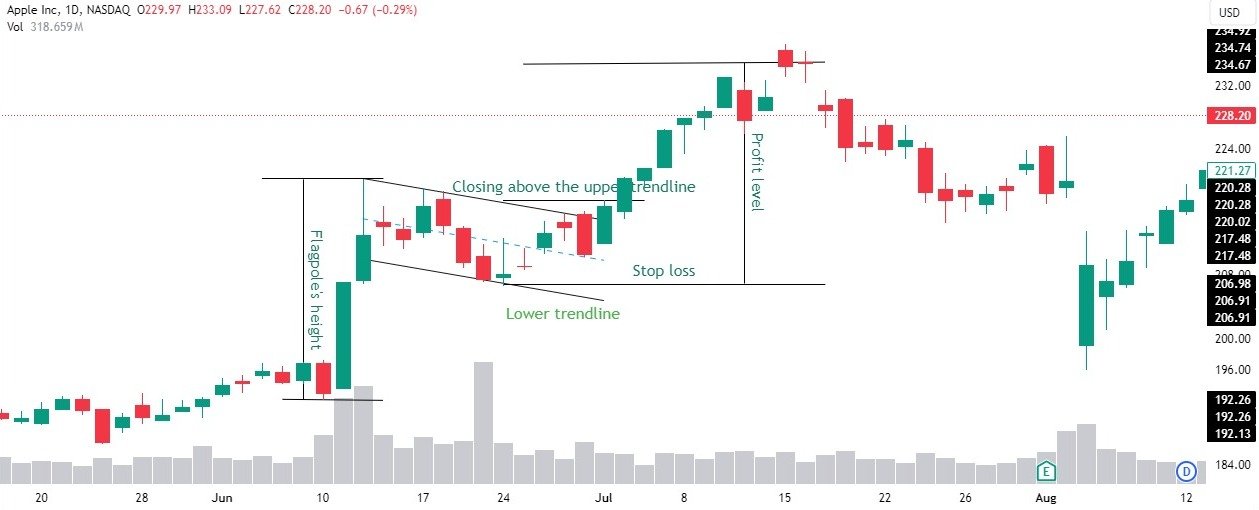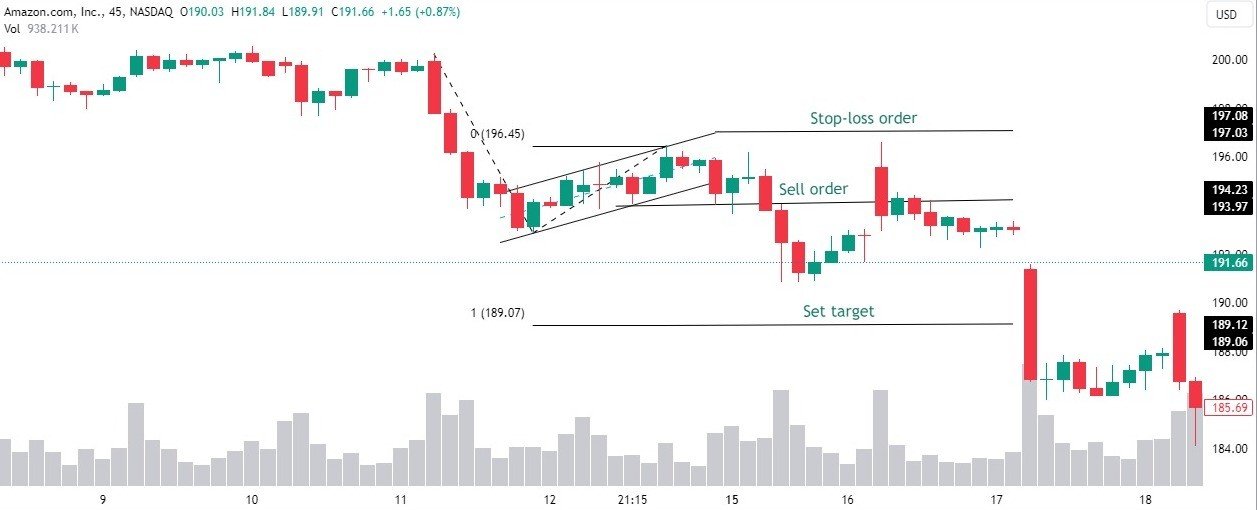Flag Pattern Trading Strategy
You don’t need to worry about complicated hypotheses or do many checks before executing a trade. The flag pattern trading requires just a few key pricing points before you can begin making money with ease.
Anyone can see a flag formation if they use trendlines to draw a line from the highs and lows. Here, you’ll find detailed instructions on how to flag pattern trade utilizing this simple chart pattern. Are you prepared to transform basic lines into rich profits? Get ready to swap flag patterns like a pro!
What is a flag pattern in trading?
When prices level off after a sudden surge, a flag appears in flag pattern trading, suggesting that the trend may be going strong. If you’re looking for a bullish flag pattern, you should wait for the price to close higher after breaking above the top trendline. When the price continues to rise after the candle closes above the trendline, you should join the trade. Here, you can set your stop loss on the lower trendline.
When a bearish flag pattern forms, the approach is the total opposite. If the price keeps falling after breaking below the lower trendline, you may enter the trade. You should place your stop-loss order on the top trendline.
In both scenarios, we often use the flagpole’s length or the first sharp move that formed the pattern to determine the profit goal.
Flag pattern rules
There are precise guidelines to follow in flag pattern trading in order to recognize and trade the pattern efficiently.
1. A strong flagpole formation
The flagpole, a very powerful and sudden price movement in one direction, is the first stage of the pattern. This is the starting point for each trend, bullish or bearish.
2. Consolidation phase (flag)
Following the flagpole, the price pauses or consolidates for a brief period. As the price moves sideways or slightly against the trend, the consolidation forms a small rectangle or parallelogram.
This creates the shape of the flag. Two parallel trendlines sloping against the flagpole should constrain the consolidation; the lower trendline should contain bullish flags, while the upper trendline should contain bearish flags.
3. Identifying trendlines
Locate the flag by tracing two parallel trendlines around the consolidation area. During the consolidation period, these lines show the price’s high and low points.
4. Confirmation of breakout
We verify the flag pattern when the price breaks out of the consolidation and continues in the direction of the beginning trend. Flags up indicate bullish patterns, flags down indicate bearish patterns. You may enter a trade when the price breaks beyond the flag’s trendlines.
5. Set stop loss at opposite trendline
To avoid losing money, set your stop loss just outside the trendline, which runs counter to the breakout wave. The lower trendline is a suitable place to set a stop loss when trading bullish flag formations. In bearish flag formations, the higher trendline serves as the stop loss.
6. Target based on flagpole length
Determine how far the flagpole (the first sharp move) is from the breakout point, and use that distance as your profit goal. In most cases, this is the expected price action after a breakout.
If you follow these guidelines, you’ll be able to use flag pattern trading with confidence and profit from market momentum.
How to trade bullish flag pattern?
Consider Apple Inc. stock as an example of a bullish flag pattern in this trading example of flag patterns.
As you can see, we have a daily live market example from Apple Inc. What follows is an outline of what you need to do to trade a bullish flag pattern.

AAPL / Daily Chart
Step 1: Identify the flag pattern trade
After a strong upswing, hold tight until the flag forms. If you see price action that is flat or slightly falling, it might be a consolidation period. At this point of consolidation, draw the top and bottom trendlines.
Step 2: Enter the trade
Keep an eye out for a candle that closes above the flag’s upper trendline. When that occurs, you may join the trade by placing a buy limit order at the high of that candle.
Step 3: Place the stop loss
The flag’s lower trendline is a suitable place to set a stop loss. Just in case the breakout doesn’t work and the price turns back, this will reduce the potential exposure to risk.
Step 4: Set your target
Get a sense of how far up from the breakout point you can estimate the flagpole’s height, which represents the starting upswing. This may determine your desired profit level.
How to trade bearish flag pattern?
Here we will examine flag pattern trading using a bearish flag as an example. In 45 minutes, we will refer to a recent Amazon.com setup.
Following a sharp drop, the price formed a bearish flag pattern, consolidating higher.

AMZN / 45 Min Chart
Step 1: Identify the flag pattern trading setup
Following a sudden decline, you should wait for a flag to emerge. Anticipate a little upward movement during the consolidation. At this point of consolidation, draw the top and bottom trendlines.
Step 2: Enter the trade
Hold on until the bar breaks a lower trendline. If a breakdown occurs, place the sell limit orders at the lowest point of the relevant candle.
Step 3: Position the stop loss
Place your stop-loss order at the flag’s upper trendline. This safeguards your transaction against the possibility of false breakdowns.
Step 4: Set your target
From the breakout point to the flagpole, a steep decline occurs before consolidation projects downward. You should aim for this pricing.
How to identify flag pattern?
You may easily recognize a flag pattern in flag pattern trading by following these steps:
1. Spot the flagpole
Keep an eye out for a sudden and powerful change in pricing, either upwards or downward.
2. Identify consolidation
Following the flagpole, there is a short consolidation period, during which the price moves in a flat or slightly anti-trend pattern. The result takes the form of a flag.
3. Draw trendlines
Mark two parallel trendlines around the consolidation area to contain the price action inside the flag.
4. Watch for a breakout
The price breaking out of the flag in the same direction as the initial trend confirms the validity of the flag pattern and signals a continuation of the trend. read more…
What happens after a flag pattern?
In trading flag patterns, after a flag pattern appears, the price usually breaks out in the same direction as the initial trend. For a bullish flag, the price rises, continuing the previous uptrend, while for a bearish flag, the price falls, continuing the previous downtrend.
This breakout indicates the continuation of the trend, prompting traders to open positions anticipating further movement. Since the price frequently moves a comparable amount after the pattern finishes, the typical method for determining the profit objective is to measure the flagpole’s height and project it from the breakout point.
Flag pattern breakout
If the price advances beyond the consolidation phase (the flag) and continues in the same direction as the previous trend, it is considered a flag pattern breakout in flag pattern trading. Breakouts in bullish flag analysis occur when prices close above the upper trendline, indicating that the uptrend will continue.
Breakouts below the lower trendline are indicative of a bearish flag, suggesting the downtrend is likely to persist. During this breakout, traders often initiate trades, estimating their target profit based on the length of the flagpole.
Final Thoughts
Finally, like with any trading system, rigorous discipline is essential for success in flag pattern trading. Being patient is key.
When you enter a transaction before the correct setup has occurred, you are introducing unnecessary risk. Following the method requires patience as you wait for the breakout and establish a stop loss.
Making the correct decision at the appropriate moment is more important than trying to seize every possible chance in trading. Consistent earnings with little risk are within your reach if you learn the flag pattern and stick to your trading plan. All set to make clever trades?
Disclaimer
This article is provided for informational purposes only and does not offer financial advice. Trading and investing involve risk, and past performance is not a guarantee of future outcomes. Before making investment decisions, readers should conduct their own research and consider their individual circumstances. The author and platform are not responsible for any financial losses or damages resulting from the use of this information. Get personalized advice from a trained financial counselor.













Leave a Reply